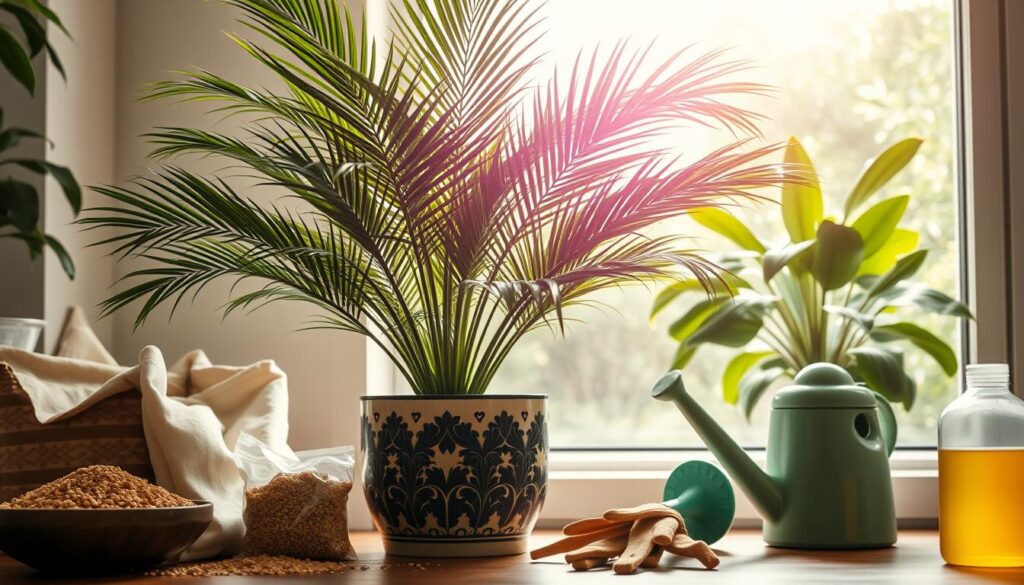Are you thinking of adding some green to your home? You want something beautiful and safe for pets. The Areca Palm is perfect for this. It’s easy to grow and brings many benefits to your space.
The Areca Palm is easy to care for. It’s small, about 4″ to 6″ wide and 8″ to 10″ tall. It also cleans the air, making your home healthier.
By following the right care tips, you’ll enjoy many benefits. The Areca Palm is safe for pets and purifies the air. It’s a great choice for adding greenery or improving air quality. With a 4.9 out of 5 stars rating, it’s clear many people love it.
Introduction to Areca Palm and Its Benefits
The Areca Palm is a popular houseplant. It looks elegant and has many benefits. Adding this plant to your home can make your life better.
It purifies the air and adds moisture. This makes it great for homes with pets or people with breathing problems.
Overview of Areca Palm
The Areca Palm is safe for pets and people. It can grow up to 8 feet tall. With the right care, it can live for about 10 years.
It needs regular food and water. This makes it easy to care for, even for those who are busy.
Health Benefits of Areca Palm
The health benefits of Areca Palm are many. It cleans the air and adds moisture. This is good for indoor spaces.
It also helps reduce stress and makes you feel happier. This makes it a wonderful addition to any home or office.
Why Choose Areca Palm for Indoor Spaces
The Areca Palm is a beautiful choice for indoors. It’s easy to care for and safe for pets and people with allergies. It’s perfect for improving air quality or adding beauty to your space.
Ideal Conditions for Growing Areca Palm
To make your Areca Palm happy, give it the right stuff. It likes indirect light, which is great for dark rooms. It also does well in warm temperatures, but it’s okay with a little change.
For soil, choose something that drains well to avoid root rot. The best soil is slightly acidic, with a pH of 6 to 6.5. This keeps the leaves green and the plant healthy. With the right light and soil, your Areca Palm will be beautiful and safe for pets.
Light Requirements
The Areca Palm likes indirect light but can handle some direct sun. It’s key to find a balance. Too much sun can burn the leaves.
Temperature Preferences
The Areca Palm loves warm temperatures, between 65-75°F. But it’s okay with a bit of change. Just keep it away from cold drafts and big temperature swings.
Best Soil for Areca Palm
The best soil for Areca Palms drains well and is slightly acidic. Mix peat moss, perlite, and vermiculite for a great soil. It keeps the roots healthy and the plant thriving.
Watering Guidelines for Areca Palm
Watering your Areca Palm right is key. Too much water can cause root rot. Too little can turn leaves yellow. Water it well, then let the soil dry before watering again.
This is crucial in spring and summer when it grows fast.
Watch for signs of overwatering like droopy leaves. Brown or crispy leaves mean it’s not getting enough water. Adjust your watering to keep your plant happy.
- Water your plant when the top inch of soil feels dry to the touch
- Reduce watering frequency during the fall and winter months
- Use filtered or distilled water to prevent mineral buildup
- Monitor soil moisture regularly to find the “Goldilocks Zone” – not too dry, not too wet, but just right
Follow these tips and watch for signs of overwatering. Your Areca Palm will flourish. It will purify the air and add beauty to your home.
Fertilizing Your Areca Palm
To help your Areca Palm grow well, you need to fertilize it. Use a balanced fertilizer with a 10-10-10 or 20-20-20 ratio. Fertilize once a month from spring to fall.
Look for palm fertilizers that are made just for palms. You can also use organic stuff like coffee grounds or slow-release spikes. But, always follow the fertilizer’s instructions and don’t overdo it.

- Dilute the fertilizer to half the recommended strength to prevent root burn.
- Apply the fertilizer evenly, avoiding direct contact with the roots.
- Flush the soil with plain water once a month to eliminate mineral salt buildup.
| Fertilizer Type | Nitrogen (N) | Phosphorus (P) | Potassium (K) |
|---|---|---|---|
| 10-10-10 | 10% | 10% | 10% |
| 20-20-20 | 20% | 20% | 20% |
By following the Areca Palm fertilization schedule and using the best fertilizer options, you can help your plant thrive and enjoy its many benefits.
Pruning and Grooming Your Areca Palm
Pruning is key to caring for your Areca Palm. It keeps the plant looking good and growing well. By cutting off dead or damaged parts, you stop diseases and help new growth start. This is important for pruning Areca Palms and keeping them beautiful.
Start by checking your Areca Palm for yellow or brown leaves. These can mean it’s getting too much water or not enough nutrients. Take off these leaves to keep the plant healthy. Also, make sure it gets enough light, water, and food. For more tips, check out trusted houseplant guides.
Here are some tips for pruning and grooming your Areca Palm:
- Remove any dead or damaged leaves or stems to prevent the spread of disease.
- Prune your Areca Palm in the spring or early summer to promote healthy growth.
- Only remove 25% of the fronds at once to avoid over-pruning.
By following these tips and maintaining healthy foliage, your Areca Palm will stay beautiful. Prune it often to keep its shape and encourage growth. This is crucial for pruning Areca Palms and keeping them healthy.
| Pruning Tips | Benefits |
|---|---|
| Remove dead or damaged leaves | Prevents the spread of disease |
| Prune in the spring or early summer | Promotes healthy growth |
| Only remove 25% of fronds at once | Prevents over-pruning |
Common Pests and Diseases of Areca Palm
When you care for your Areca Palm, knowing about pests and diseases is key. Keeping an eye out and using Areca Palm pest control can stop problems. This helps your plant stay healthy.
Spider mites and mealybugs are pests that can harm your Areca Palm. They can damage leaves and stems, making them look bad and grow less. To stop them, keep your plant clean, separate new plants, and don’t water too much. This keeps pests away.
Here are some tips to fight pests:
- Check your plant often for pests like webbing or sticky stuff.
- Use insecticidal soap or neem oil to fight pests.
- Keep new plants away to stop pests from spreading.
- Don’t water too much, as it attracts pests and diseases.
For more tips on caring for your Areca Palm, check out this resource. It has great advice for keeping your plant happy.
By following these tips and watching for pests and diseases, you can keep your Areca Palm healthy. Always check your plant and act fast if you see any problems.
| Pest/Disease | Symptoms | Treatment |
|---|---|---|
| Spider Mites | Discoloration, webbing | Insecticidal soap or neem oil |
| Mealybugs | Sticky residue, discoloration | Insecticidal soap or neem oil |
Repotting Your Areca Palm
As you care for your Areca Palm, you’ll need to repot it soon. This step gives your plant fresh soil and a bigger pot. This lets the roots grow more.
Choosing the right pot is key. Pick one that’s only a bit bigger than the old one. Look for a pot that’s 1-2 inches larger in diameter.
The best time to repot is in the spring. This is when your plant grows the most. But, summer can also work if you missed spring.
Check if your plant needs a new pot by looking for signs. Look for roots showing above the soil or drainage holes. Also, check for lack of growth in spring and summer, or salt on the soil.
Here are some tips for repotting your Areca Palm:
- Use a potting mix that drains well to avoid soggy soil
- Choose a pot that’s just a bit bigger to keep the soil right
- Avoid repotting in fall or winter when the plant is sleeping
- Keep the temperature warm, above 59°F, to avoid stressing the plant
By following these tips and picking the right pot, you’ll help your Areca Palm grow well. Be gentle with the roots and water well after repotting.
With the right care, your Areca Palm will do great in its new home. It will give you beautiful leaves and clean air. Repotting every 2-3 years keeps your plant healthy and stops problems like root rot.
| Repotting Frequency | Optimal Pot Size | Ideal Soil pH |
|---|---|---|
| Every 2-3 years | 1-2 inches larger in diameter | 6.0-6.5 |
Tips for Maintaining a Thriving Areca Palm
To keep your Areca Palm happy, give it the right home. It likes bright, indirect light and warm temperatures. Keep it between 75-85°F during the day and above 65°F at night.
Change how you care for it with the seasons. In spring and summer, it needs more humidity. In fall and winter, water and fertilize less. These changes help your palm stay healthy and beautiful.
Monitoring Plant Health
Check your Areca Palm often for pests, diseases, or nutrient needs. Look for yellow or brown leaves and dry soil. Catching problems early helps prevent big issues.

- Water it once a week, letting the soil dry a bit
- Fertilize with a liquid houseplant fertilizer (NPK 12-4-12) 2-3 times a year
- Repot it every 2 years to refresh the soil and remove old fertilizer
By following these tips and caring for your Areca Palm, you’ll enjoy its beauty and air-purifying benefits.
| Season | Temperature | Humidity | Watering |
|---|---|---|---|
| Spring/Summer | 75-85°F | High | Once a week |
| Fall/Winter | 65-75°F | Low | Every 10 days |
The Importance of Areca Palm for Indoor Air Quality
The Areca Palm (Dypsis lutescens) is a beautiful plant for your home. It also helps keep the air clean. This plant is great at removing bad stuff like formaldehyde and benzene from the air.
Air-Purifying Qualities
Studies show the Areca Palm is very good at cleaning the air. It takes out harmful toxins and makes more oxygen. This makes your home or office healthier and more refreshing.
Impact on Home Environment
Adding an Areca Palm to your space can really change things. It makes the air better and can even lower stress. This can make you feel happier and more productive.
Enhancing Well-being with Plants
The Areca Palm is a great choice for any room. It makes the air cleaner, lowers stress, and makes you feel better. Plus, it looks beautiful and adds to the beauty of your space.
Read about other great pet safe houseplants in our article, 8 Best Pet-Friendly Houseplants for a Happy Home.





Pingback: 8 Best Pet-Friendly Houseplants for a Happy Home - Trusted House Plant Guide
Pingback: The Ultimate Guide to Houseplants: 100 Best Indoor Plants for Every Home - Trusted House Plant Guide